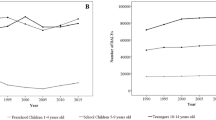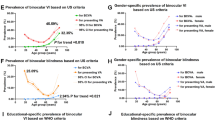Abstract
Backgrounds
Although vision care is crucial for pediatric eye health, research on vision care utilization by children with disabilities remains limited. Furthermore, no study has investigated the variations among various disability types and the interaction between disability status and age.
Methods
All children with disabilities listed in the Taiwan National Disability Registry during the study period (2015–2019) were matched by age and sex at a 1:4 ratio with children without disabilities. Vision care needs were measured on the basis of (1) the number of outpatient ophthalmology visits, (2) total medical costs associated with outpatient ophthalmology visits, and (3) whether ophthalmic care was provided. Generalized estimating equation models were estimated to determine the relationships between utilization, disability status, and age.
Results
Significant differences in needs between various disability types were identified. Other than children with visual disability, children with facial disability and balance abnormalities also had considerable needs. Children with intellectual disabilities, which constituted the most common disability type (29.4% in 2019), had fewer visits (mean = 1.38, SD = 2.12) and lower medical costs, compared with the averages for all children with disabilities. Care utilization shared an inverted U-shaped relationship with age.
Conclusions
Children with disabilities have higher vision care needs, which vary by disability type and age. Such needs are greater at younger ages and decreases after the ages of 9–10 years. Policies should be specific to disability type and age to ensure vision care needs are met.
This is a preview of subscription content, access via your institution
Access options
Subscribe to this journal
Receive 18 print issues and online access
$259.00 per year
only $14.39 per issue
Buy this article
- Purchase on Springer Link
- Instant access to full article PDF
Prices may be subject to local taxes which are calculated during checkout


Similar content being viewed by others
Data availability
The data that support the findings of this study are available from the Taiwan Ministry of Health and Welfare but restrictions apply to the availability of these data, which were used under license for the current study, and so are not publicly available.
References
UNICEF. Children with disabilities overview. https://data.unicef.org/topic/child-disability/overview/; Accessed 15 July, 2022.
Cui Y, Stapleton F, Suttle C. Developing an instrument to assess vision‐related and subjective quality of life in children with intellectual disability: data collection and preliminary analysis in a Chinese population. Ophthalmic Physiol Opt. 2008;28:238–46.
Simon GR, Boudreau ADA, Baker CN, Barden GA, Hackell JM, Hardin AP, et al. Visual system assessment in infants, children, and young adults by pediatricians. Pediatrics. 2016;137:28–30.
Berry JG, Hall M, Neff J, Goodman D, Cohen E, Agrawal R, et al. Children with medical complexity and Medicaid: spending and cost savings. Health Aff. 2014;33:2199–206.
Croen LA, Najjar DV, Ray GT, Lotspeich L, Bernal P. A comparison of health care utilization and costs of children with and without autism spectrum disorders in a large group-model health plan. Pediatrics. 2006;118:e1203–11.
Kancherla V, Amendah DD, Grosse SD, Yeargin-Allsopp M, Braun KVN. Medical expenditures attributable to cerebral palsy and intellectual disability among Medicaid-enrolled children. Res Dev Disabil. 2012;33:832–40.
Hou C, Pu C. Association between visual impairment and health care utilization. Am J Ophthalmol. 2022;234:166–73.
Lin JD, Wu JL, Lee PN. Healthcare needs of people with intellectual disability in institutions in Taiwan: outpatient care utilization and implications. J Intellect Disabil Res. 2003;47:169–80.
Xiong N, Yang L, Yu Y, Hou J, Li J, Li Y, et al. Investigation of raising burden of children with autism, physical disability and mental disability in China. Res Dev Disabil. 2011;32:306–11.
Salt A, Sargent J. Common visual problems in children with disability. Arch Dis Child. 2014;99:1163–8.
Nielsen LS, Skov L, Jensen H. Visual dysfunctions and ocular disorders in children with developmental delay. II. Aspects of refractive errors, strabismus and contrast sensitivity. Acta Ophthalmol Scand. 2007;85:419–26.
Roizen NJ, Mets MB, Blondis TA. Ophthalmic disorders in children with Down syndrome. Dev Med Child Neurol. 1994;36:594–600.
Creavin AL, Brown RD. Ophthalmic abnormalities in children with Down syndrome. J Pediatr Ophthalmol Strabismus. 2009;46:76–82.
Akinci A, Oner O, Bozkurt OH, Guven A, Degerliyurt A, Munir K. Refractive errors and ocular findings in children with intellectual disability: a controlled study. J Am Assoc Pediatr Ophthalmol Strabismus. 2008;12:477–81.
Schembri A, Janice Fiske D. The implications of visual impairment in an elderly population in recognizing oral disease and maintaining oral health. Spec Care Dent. 2001;21:222–6.
Ribeiro MV, Hasten-Reiter Júnior HN, Ribeiro EA, Jucá MJ, Barbosa FT, Sousa-Rodrigues CF. Association between visual impairment and depression in the elderly: a systematic review. Arquivos brasileiros de oftalmologia. 2015;78:197–201.
Teoh LJ, Solebo AL, Rahi JS, Abbott J, Abdullah W, Adams G, et al. Visual impairment, severe visual impairment, and blindness in children in Britain (BCVIS2): a national observational study. Lancet Child Adolesc Health. 2021;5:190–200.
Reijneveld S, Stronks K. The impact of response bias on estimates of health care utilization in a metropolitan area: the use of administrative data. Int J Epidemiol. 1999;28:1134–40.
Khare SR, Vedel I. Recall bias and reduction measures: an example in primary health care service utilization. Fam Pract. 2019;36:672–6.
Taiwan Ministry of Health. https://www.mohwgovtw/cp-16-67980-1html; Accessed 23 June, 2022.
Taiwan National Health Insurance Adminstration. Taiwan National Health Insurance annual executive report. Taipei, Taiwan 2022.
Kuo DZ, Cohen E, Agrawal R, Berry JG, Casey PH. A national profile of caregiver challenges among more medically complex children with special health care needs. Arch Pediatr Adolesc Med. 2011;165:1020–6.
Harris H. Meeting the needs of disabled children and their families: Some messages from the literature. Child Care Pract. 2008;14:355–69.
Kemper AR, Cohn LM, Dombkowski KJ. Patterns of vision care among Medicaid-enrolled children. Pediatrics. 2004;113:e190–6.
Taiwan National Health Insurance Adminstration. https://www.nhi.gov.tw. Accessed 1 Agusust, 2022.
Global Health Expenditure Database, the World Health Organization. https://apps.who.int/nha/database. Accessed 26 July, 2023.
Yekta A, Hooshmand E, Saatchi M, Ostadimoghaddam H, Asharlous A, Taheri A, et al. Global prevalence and causes of visual impairment and blindness in children: A systematic review and meta-analysis. J Curr Ophthalmol. 2022;34:1.
World Health Organization. Blindness and vision impairment. https://www.who.int/news-room/fact-sheets/detail/blindness-and-visual-impairment. Accessed 1 Agusust, 2022
Shaw D, Minshull C, Fielder A, Rosenthal A. Amblyopia—factors influencing age of presentation. Lancet. 1988;332:207–9.
Balasubramaniam SM, Kumar DS, Kumaran SE, Ramani KK. Factors affecting eye care–seeking behavior of parents for their children. Optom Vis Sci. 2013;90:1138–42.
Holmes JM, Levi DM. Treatment of amblyopia as a function of age. Visual Neurosci. 2018;35:e015.
Keech RV, Kutschke PJ. Upper age limit for the development of amblyopia.^Vol 32: SLACK Incorporated Thorofare, NJ; 1995:89-93.
Aarthun A, Akerjordet K. Parent participation in decision‐making in health‐care services for children: an integrative review. J Nurs Manag. 2014;22:177–91.
Newacheck PW, Hughes DC, Hung Y-Y, Wong S, Stoddard JJ. The unmet health needs of America’s children. Pediatrics. 2000;105:989–97.
Sloper P, Lightfoot J. Involving disabled and chronically ill children and young people in health service development. Child Care Health Dev. 2003;29:15–20.
Franklin A, Sloper P. Supporting the participation of disabled children and young people in decision‐making. Child Soc. 2009;23:3–15.
Lai DC, Tseng YC, Guo HR. Trends in the prevalence of childhood disability: analysis of data from the national disability registry of Taiwan, 2000-2011. Res Dev Disabil. 2013;34:3766–72.
Funding
The study was supported by the Ministry of Science and Technology (National Science and Technology Council), Taiwan. Grant number: 112-2314-B-A49 -052 -MY3 and Health and Welfare Data Science Center, NYCU Branch.
Author information
Authors and Affiliations
Contributions
CP conceptualized the study and obtained the data. CP and CH analyzed the data, interpreted the results, and wrote the manuscript together.
Corresponding author
Ethics declarations
Competing interests
The authors declare no competing interests.
Additional information
Publisher’s note Springer Nature remains neutral with regard to jurisdictional claims in published maps and institutional affiliations.
Supplementary information
Rights and permissions
Springer Nature or its licensor (e.g. a society or other partner) holds exclusive rights to this article under a publishing agreement with the author(s) or other rightsholder(s); author self-archiving of the accepted manuscript version of this article is solely governed by the terms of such publishing agreement and applicable law.
About this article
Cite this article
Pu, C., Hou, CH. Ophthalmic health care needs of children with disabilities. Eye 38, 481–487 (2024). https://doi.org/10.1038/s41433-023-02707-5
Received:
Revised:
Accepted:
Published:
Issue Date:
DOI: https://doi.org/10.1038/s41433-023-02707-5



